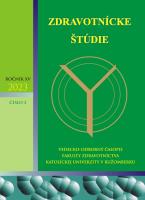Terapia chôdze u pacientov s centrálnou hemiparézou s použitím zariadenia walkaide
Gait Therapy in Patients With Central Hemiparesis Using the Walkaide Device
Author(s): Peter Mačej, Marina Potašová, Peter Kutiš, Silvia Pilarčíková, Alexandra Melišová, Martin KomárSubject(s): Health and medicine and law
Published by: VERBUM - vydavateľstvo Katolíckej univerzity v Ružomberku
Keywords: Hemiparesis; Vascular stroke; Robotically assisted walking; Neurorehabilitation
Summary/Abstract: A stroke is defined as a sudden disruption of the blood supply to the brain tissue. It is the third leading cause of death after heart disease and cancer. The number of individuals with a stroke in the Czech Republic is 350 patients per 100,000 individuals per year. This means that roughly 35,000 people suffer from a stroke in the Czech Republic every year. Patients who have survived a stroke often suffer from hemiparesis, which affects the stereotype of walking. Acharacteristic feature of hemiparetic gait is circumduction movement in the hip joint and weakening of the ankle extensor groups, reduced speed, shorter step length and less load on the paretic limb. As part of the rehabilitation, it is possible to stimulate the paretic lower limb using the WalkAide. It is a type of functional electrical stimulation, which causes irritation of the peripheral nerve and subsequent activation of the paretic muscle. The aim of the presented study was to propose a methodology for objectifying the influence of electrical stimulation using WalkAide on selected walking parameters.
Journal: Zdravotnícke štúdie
- Issue Year: XV/2023
- Issue No: 2
- Page Range: 23-26
- Page Count: 4
- Language: Slovak

